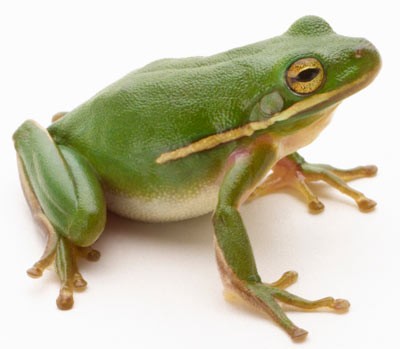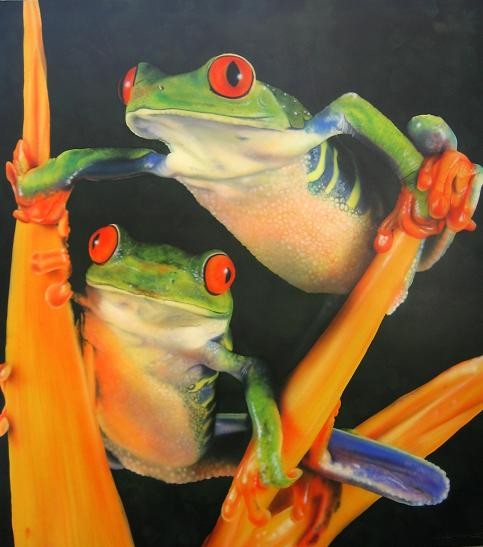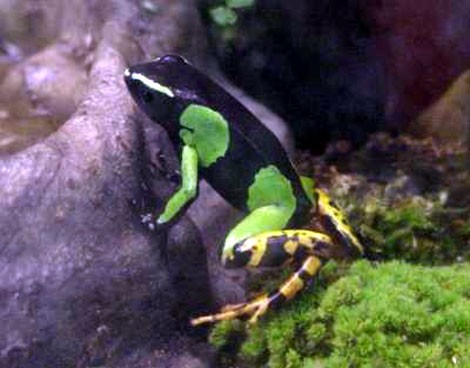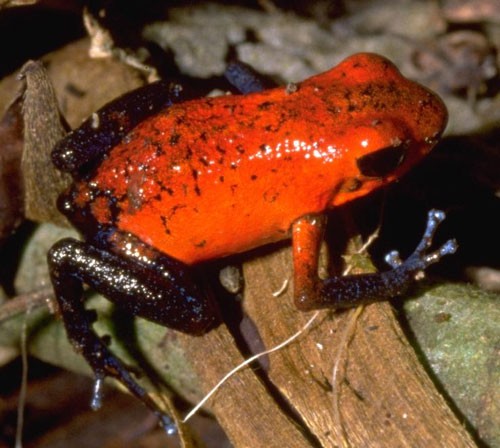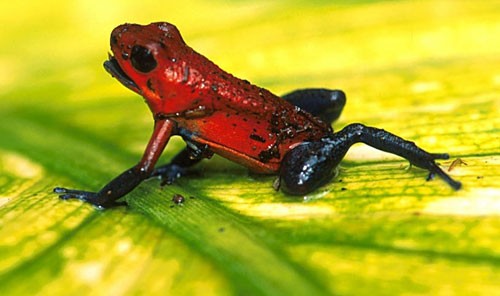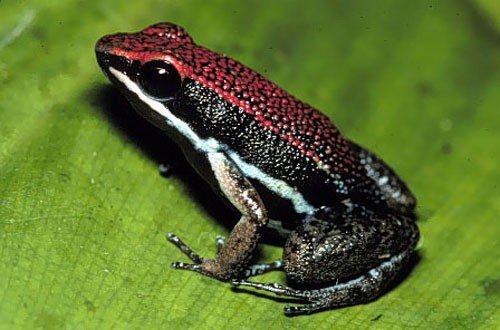Frogs- A Chorus of Colors at the Berkshire Museum
New Exhibition Croaks in Pittsfield June 13 to November 1
By: Ariel Petrova - Apr 24, 2009
"Frogs – A Chorus of Colors," on view at Berkshire Mueeum from June 13 through November 1, 2009, introduces visitors to the amazing world of frogs. Sporting a dazzling array of colors, from tangerine to electric blue, frogs come in a wide range of shapes and sizes, ranging from a half an inch long to 15 inches and weighing up to seven pounds. There are more than 4,000 species of frogs throughout the world, and exhibition visitors will be immersed in the sights and sounds of a wide variety of living frogs, including delicate tree frogs, fat bullfrogs, bizarre horned frogs, giant toads, and elegant dart poison frogs. Visitors can activate recorded frog calls, view videos of frogs in action, spin a zoetrope, and perform a virtual frog dissection. The exhibition is sponsored by Greylock Federal Credit Union.
"We're thrilled to present this visually stunning and educational exhibit at the Berkshire Museum," said Executive Director Stuart A. Chase. "It's an ideal opportunity for children and families to explore the astounding world of frogs in galleries transformed into an oasis of peaceful waterfalls and a symphony of song. Everyone will be able to get to know some of the earth's most fascinating creatures in an up-close and personal way."
These amphibians are among the most diverse life forms on earth and can be found in a wide range of climates, from tropical forests to frozen tundra and scorching deserts, they exist on all continents except Antarctica. Having first roamed the earth more than 360 million years ago, their ancestor's chorus of song filled the night since the dawn of the dinosaurs. But the chorus is fading. Frogs are one of nature's most delicate animals, acting as climate canaries as environments around the world change. Part of the exhibition focuses on why endangered frogs are disappearing from our backyards as well as the most remote rainforests.
The exhibition was created by Clyde Peeling's Reptiland in Allenwood, Pennsylvania, an institution accredited by the American Zoo and Aquarium Association, and features self-contained custom habitats that provide lighting, humidity, temperature, and water quality control to meet the needs of these delicate creatures. The exhibit's habitats are precisely replicated and include rock ledges, live plants, and waterfalls for the frogs to thrive in. Stunning backlit graphic panels with colorful images of frogs cover the walls, and interactive components invite visitors to activate recorded frog calls, view videos of frogs jumping, swimming or gliding from dizzying heights, spin a zoetrope, and test new-found frog knowledge on subjects from the most basic to the totally bizarre, such as the difference between a toad and a frog.
The exhibition explores all aspects of frogs: their basic biology, ecology and lifecycles; their role in human cultures; their importance to fragile ecosystems; and the peril they face in a rapidly changing environment. The exhibition is full of spectacular close-up photographs by world-renowned wildlife photographers Joe and Mary Ann McDonald, John Netherton, Michael and Patricia Fogden and others. These stunning images offer a glimpse of the vast pallet of frog diversity.
There is an additional fee for "Frogs – A Chorus of Colors." Admission for adults is $11, $6 children ages 3-18, and $1 for Berkshire Museum members of all ages.
Exhibited Species
1. American Bullfrog - Bullfrogs are named for their loud, deep mating calls. They eat insects, fish, birds, snakes, baby turtles and other frogs. Bullfrogs are native to the eastern U.S., but they have been released west of the Rocky Mountains where they have devastated local populations of frogs and other small animals.
2. Tadpoles - Most frogs begin life as fish-like tadpoles. Tadpoles exist to eat and grow and later sprout legs and loose their tails. This change from tadpole to frog is called metamorphosis.
3.Vietnamese Mossy Frog - Mossy frogs take camouflage to a new level! Spotty skin, bumps, spines, and tubercles make them look like little clumps of moss or lichen. They inspire visual "treasure hunts" where kids compete to see who can find the most frogs.
4. African Bullfrog - Adult African Bullfrogs look strikingly like the Star Wars character Jabba the Hutt. These giant frogs can grow up to eight inches in diameter and live for 40 years. They eat almost anything – insects, small mammals and even other frogs!
5. Smooth-sided Toad - Although they have no teeth, smooth-sided toads are bold predators. They catch prey with long, sticky tongues and swallow it alive. Some large toads eat almost anything they can fit in their mouths including mice, birds, snakes, and other frogs.
6. Chinese Gliding Frog - These beautiful tree frogs have enlarged webbing between the toes. When leaping between branches or escaping toward the ground, the toes spread and the webbing acts like a parachute. Although no frogs can truly fly, gliding frogs can soar and land gracefully from daunting heights.
7. African Clawed Frog - These bizarre frogs look like they have been flatted in a traffic accident. They stand upright underwater with forearms outstretched and wait for food. When a fish swims near the frog, it opens its mouth, causing an inrush of water. It uses its front legs to stuff the prey down its throat.
8. Budgett's Frog - Budgett's frogs look like they're from another planet! The round squat body jiggles like a bag of water when the frog moves and the eyes sit atop the head like a pair of tiny ping pong balls. When this frog is frightened it opens its huge mouth, screams like a cat in pain and lunges toward an aggressor.
9. Ornate Horned Frog - These opportunistic hunters sport intricate patterns of brown, green, red, and black markings that provide camouflage against the leaf litter of a rainforest floor. They pounce on a passing prey animal with remarkable speed, eating mice, beetles, snakes and other frogs. During dry periods, they encase themselves in a thick layer of dead skin.
10. Golden Mantella Frog - The golden mantella frog from Madagascar is astonishingly bold for its size. Like the poisonous Dart Frogs of the Americas, mantellas are active during the day and warn away predators with their bright skin color. But the skin secretions of mantellas are not especially toxic. These brightly colored frogs gain protection by looking dangerous.
11. Fire-bellied Toad - These mostly aquatic creatures have the warty skin of a toad, but swim and require moisture like pond frogs. When in groups, fire-bellied toads are often seen in amplexus, the mating posture where males grasp females around the waist to fertilize eggs. These frogs use skin colors for protection. The back side of the toad is green and black, providing camouflage from above. When disturbed, they throw their legs into the air revealing a bright red "fire belly" to startle the intruder.
12. Dumpy Tree Frog - Unlike most tree frogs, these are robust, heavy-bodied animals. Their large speckled eyes, rolling folds of skin and comical postures make these frogs charming exhibit animals. Mucous-covered toepads allow tree frogs to climb straight up trees, cling to the undersides of leaves or hang preposterously from a branch by one toe.
13. Waxy Monkey Frog - South American monkey frogs climb through trees with grasping feet. The waxy monkey frog is unusual in its preference for hot, dry conditions. By recycling water in its kidneys, the frog is able to avoid expelling precious moisture in the form of urine. It also gives itself a rubdown with a waxy secretion to limit water loss through the skin.
14. Dart Poison Frogs - Dart Poison Frogs from the rainforests of the Americas come in a dizzying array of colors and patterns. Some are used by native tribes to poison the tips of blowdarts for hunting. Complex compounds in the skin secretions of dart frogs are now being studied by scientists for potential medical use. These hopping pharmacies have already provided a possible substitute for morphine which is non addictive and 100 times more potent.
15. Smokey Jungle Frog - These tropical American frogs have impressive size and bulk. The meat from their powerful hind legs is prized throughout their range as a delicacy known locally as 'mountain chicken'. When disturbed, they open their mouths and produce a loud "squawk".
Interactive Components
1. The Frog Frame - Check out the skeleton of the world's largest frog, the African goliath frog. Learn how the frog's skeleton allows it to out jump Olympic athletes.
2. Metamorphosis – Examine the stages of metamorphosis with preserved specimens.
3. Find a Frog - Some frogs are incredibly good at blending into their environments. Can you find the hidden frogs in these photos?
4. Frog or Toad? – Try to guess the differences between frogs and toads - it's not as easy as it sounds.
5. On the Move - Push buttons to activate video clips of frogs jumping, swimming, walking, climbing, and gliding.
6. Leap Frog – Spin an old-fashioned zoetrope to see how a frog jumps.
7. Catching Food - Push buttons to activate video clips of frogs eating.
8. Create a Chorus - Push buttons to activate recorded frog calls. Overlap them to make a chorus.
9. Fun Frog Facts - Test your frog IQ on subjects from basic to bizarre.
10. Nests and Nurseries - Learn how various frogs protect their eggs and tadpoles.
11. Froguts - Perform a virtual frog dissection without hurting any frogs.
Curious Frog Facts
1. What is the difference between a frog and a toad? - Toads are frogs. The word "toad" is usually used for frogs that have warty skin, short hind legs and live on land.
2. What is the world's largest frog? - The goliath frog of west Africa is the world's largest. It can grow to 15 inches and weigh up to 7 pounds - about the size of a newborn human.
3. What is the world's smallest frog? The smallest may be the Cuban tree toad which only grows to 1/2 inch long.
4. How many kinds of frogs are there? At last count there were over 4,000 species of frogs worldwide, but scientists continue to find new ones every year.
5. Do frogs drink? No. Most frogs absorb all of their water through their skin. Many have a "special drink" patch on the belly.
6. Are there frogs that can kill a person? No frog is truly a threat to humans, but some can be dangerous if handled or eaten. There are at least three species of frogs in South America with skin toxins capable of killing a human - the golden poison frog carries enough poison to kill 10 people!
7. How many eggs does a frog lay? Some frogs lay only a few eggs, others lay as many as 30,000 at a time.
8. Can you get warts from a toad? No. Toad "warts" are actually thickenings in the skin or clusters of specialized glands. They are not contagious.
9. Could a dinosaur have stepped on a frog? Yes. Frogs have been on earth for some 360 million years. They predated and outlived most of the dinosaurs.
10. Do frogs shed their skins? Yes. Like their cousins the reptiles, most frogs shed the outer layer of skin by twisting and stretching – they often eat the dead skin as it comes off.
Berkshire Museum is located at 39 South Street on Route 7 in downtown Pittsfield Berkshire Museum is open Monday through Saturday, 10 a.m. to 5 p.m., and Sundays, noon to 5 p.m. Admission is $10 adults, $5 children 3-18. Members and children under 3 are admitted free. For more information, contact the Berkshire Museum at 413.443.7171, ext. 10, or frontdesk@ berkshiremuseum.org.

